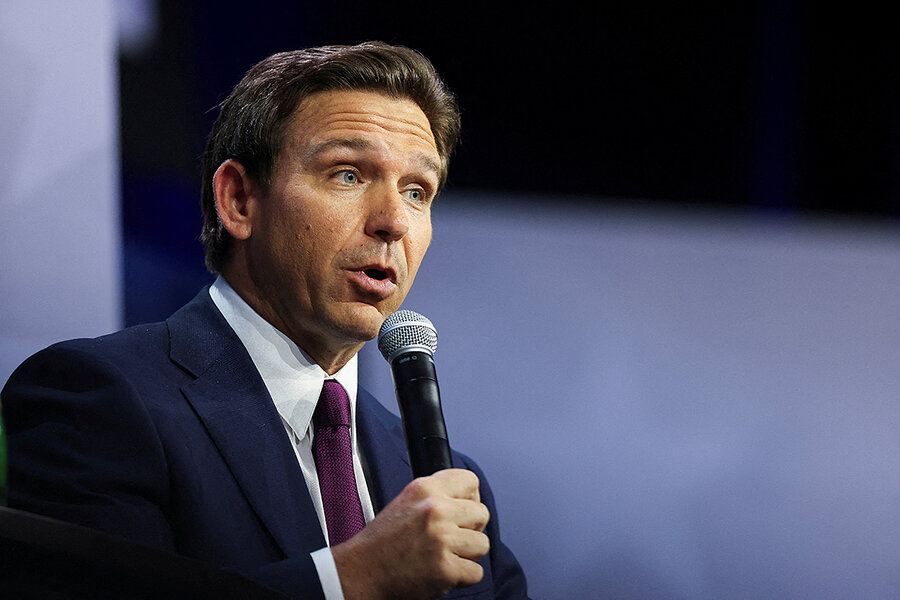Behind Florida’s slavery curriculum, a bigger question
Loading...
Florida Gov. Ron DeSantis is not backing down. His state’s new public school curriculum on slavery does the seemingly unthinkable, suggesting that slavery held benefits for Black people. One unit mandates instruction on “how slaves developed skills which, in some instances, could be applied for their personal benefit.”
There’s debate about what this does or doesn’t mean. One analysis in The Bulwark suggests that, in its full context, the unit is about showing how enslaved people showed agency even amid the horrors of slavery.
But Mr. DeSantis’ defense of the curriculum has placed him at odds with members of his own party, including presidential primary opponents and Black Republicans. He commended the curriculum for presumably showing “that some of the folks ... eventually parlayed, you know, being a blacksmith into doing things later in life.”
Why We Wrote This
A story focused onFlorida’s slavery curriculum has caused controversy for appearing to suggest slavery had benefits. But pro-slavery ideas continue to hide in plain sight, and will continue until the commitment to a common humanity is stronger.
Such words, however hurtful and ahistorical, are not unprecedented. They remind me of the words of former Vice President John C. Calhoun. In 1837, he argued that slavery was a “positive good”:
Be it good or bad, [slavery] has grown up with our society and institutions, and is so interwoven with them that to destroy it would be to destroy us as a people. But let me not be understood as admitting, even by implication, that the existing relations between the two races in the slaveholding States is an evil: – far otherwise; I hold it to be a good, as it has thus far proved itself to be to both, and will continue to prove so if not disturbed by the fell spirit of abolition. I appeal to facts. Never before has the black race of Central Africa, from the dawn of history to the present day, attained a condition so civilized and so improved, not only physically, but morally and intellectually.
Neither Florida’s curriculum nor Mr. DeSantis’ comments go nearly that far. Yet for generations, Calhoun’s pro-slavery and anti-Black views have been hidden in plain sight. In North Augusta, South Carolina, there is an obelisk that honors the only white man killed when white supremacists massacred members of a local Black militia in an effort to overthrow civil rights in 1876. It reads: “In life he exemplified the highest ideal of Anglo-Saxon civilization. By his death he assured to the children of his beloved land the supremacy of that ideal.”
That obelisk stands in Calhoun Park.
A few miles downhill, as the waters of the Savannah River turn North Augusta into Augusta, Georgia, the major roadway is the John C. Calhoun Parkway.
A few dozen miles upriver lie Calhoun’s native Abbeville County and Secession Hill. On Nov. 20, 1860, citizens gathered there to adopt South Carolina’s secession from the Union. It has since been heralded as the “birthplace of the Confederacy.”
My father is from Abbeville County, and I still live in the Augusta area. For me, John C. Calhoun and his words are not a part of history. They stand not far from my door, inscribed in stone. They follow me as I drive my car. They mercilessly stalk the present, carefully cultivated reminders of a past never quite rejected, often embraced.
How can such inhumanity endure – the adamant assertions of second-class citizenship? One answer could be that the strength of past ideologies and institutions endures until the rebuke of them is stronger.
It starts with how we present history. In U.S. classrooms, there are efforts to dilute or erase Black studies and Black history by co-opting and weaponizing words and phrases such as “woke” or “critical race theory.” Those words have a meaning, but rather than working to understand their relevance, opponents have dismissed them – and so have dismissed the people to whom those words matter deeply. We will define you and your lexicon as we see fit, they appear to be saying. This is part of the white supremacy ethos.
In 1850, Calhoun fought against California’s admission to the Union as a free state. As a solution, the Compromise of 1850 was struck. California could enter as a free state, but fugitive slave laws would be strengthened. The slave trade would be outlawed in Washington, D.C., but slavery itself could continue.
I look at the Compromise of 1850 and various compromises in the years to follow, and I see the wiggle room that allows for injustice. A land established in the name of independence and good conscience – in which many founders acknowledged the terrible moral cost of slavery and yet allowed it – once again refused to live by its own ideals. As a result, its capitalism became inextricably intertwined with chattel slavery.
So history has repeated itself. The Civil Rights and Voting Rights acts, for all of their nobility, were still concessions. They represent allowances, in a still-unequal nation, of the rights that are essential to democracy – not just voting, but the rights of life, liberty, and pursuit of happiness through housing and health care. When our rebuke of racism is mild, disparities find space to endure.
How do we teach Black history? How do we treat monuments to white supremacy? How do we talk about slavery? These questions are just the beginning, frankly. The goal has always been full citizenship, and beyond that, to never have to compromise when it comes to our humanity.







